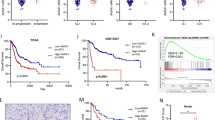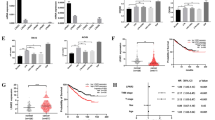Abstract
Autotaxin (ATX) as an important tumor cell motility-stimulating factor is upregulated in many different types of cancer. ATX, a member of the ectonucleotide pyrophosphatase and phosphodiesterase family of enzymes, possesses lysophospholipase D activity which hydrolyzes lysophosphatidylcholine to generate the potent tumor growth factor and mitogen lysophosphatidic acid (LPA). LPA acts on specific G-protein-coupled receptors, thereby regulating cell growth, migration, and survival. This study aimed to investigate the differences in gene expression pattern of ATX between cancerous and adjacent normal tissue of human renal cell carcinoma (RCC) and bladder carcinoma (BC) and find the correlation between ATX expression and clinicopathological features of both of these carcinomas. Both the RCC and BC tissues and with the adjacent normal tissues were collected. Immunohistochemistry and Western blotting analysis were used to detect the extent of ATX expression in all of these samples. Immunohistochemistry and Western blot analysis revealed that expression of ATX protein in carcinoma tissues is significantly higher than that in the adjacent normal tissues. Immunohistochemistry analysis showed that ATX is localized in cytoplasm. Western blotting analysis showed that ATX protein is expressed in both RCC and BC, and the expression levels were 69.5 and 48.0 %, respectively, higher in RCC and BC carcinoma tissue samples than in the adjacent normal tissues, which is consistent with the results of immunohistochemistry study. Thus, this study provided the evidence that ATX is highly expressed in both RCC and BC. Further research can be done to identify the diagnosis and treatment significance of both these carcinomas.





Similar content being viewed by others
References
Jena J. A study on natural anticancer plants. Int J Pharm Chem Sci. 2012;1(1):365–8.
Global Burden of Disease Cancer Collaboration. The global burden of cancer 2013. JAMA Oncol. 2015;1(4):505–27.
Robins SL, Cotran RS. Neoplasia. In: Kumar V, Abbas AK, Fausto N, editors. Pathologic basis of disease. 7th ed. India: Thomson Press; 2009. p. 292–306.
Ferlay J, Autier P, Boniol M, et al. Estimates of the cancer incidence and mortality in Europe in 2006. Ann Oncol Off J Eur Soc Med Oncol/ESMO. 2007;18:581–92.
Siegel R, Ma J, Zou Z, Jemal A. Cancer statistics, 2014. CA Cancer J Clin. 2014;64:9–29.
Kim SS, Choi YD, Shim MK, Kim J, Cho YM, Jang JJ, Park RJ, Juhng SW, Choi C. Microscopic and nuclear morphometric findings of chromophobe renal cell carcinoma, renal oncocytoma, and tumor with overlapping histology. Ann Diagn Pathol. 2012;16:429–35.
Lotan Y, Karam JA, Shariat SF, Gupta A, Roupret M, Bensalah K, Margulis V. Renal-cell carcinoma risk estimates based on participants in the prostate, lung, colorectal, and ovarian cancer screening trial and national lung screening trial. Urol Oncol. 2015;. doi:10.1016/j.urolonc.2015.10.011.
Solomon James P, Hansel Donna E. Morphologic and molecular characteristics of bladder cancer. Surg Pathol. 2015;8:663–76.
Burger M, Catto JWF, Dalbagni G, Grossman HB, Herr H, Karakiewicz P, Kassouf W, Kiemeney LA, La Vecchia C, Shariat S, Lotan Y. Epidemiology and risk factors of urothelial bladder cancer. Eur Urol. 2013;63:234–41.
Cholia RP, Nayyar H, Kumar R, Mantha AK. Understanding the multifaceted role of ectonucleotide pyrophosphatase/phosphodiesterase 2 (ENPP2) and its altered behaviour in human diseases. Curr Mol Med. 2015;15(10):932–43.
Tania M, Khan MA, Zhang H, Li J, Song Y. Autotaxin: a protein with two faces. Biochem Biophys Res Commun. 2010;401:493–7.
Fotopoulou S, Oikonomou N, Grigorieva E, et al. ATX expression and LPA signalling are vital for the development of the nervous system. Dev Biol. 2010;339:451–64.
Ptaszynska MM, Pendrak ML, Bandle RW, Stracke ML, Roberts DD. Positive feedback between vascular endothelial growth factor-A and autotaxin in ovarian cancer cells. Mol Cancer Res. 2008;6:352–63.
Leblanc R, Lee SC, David M, Bordet JC, Norman DD, Patil R, Miller D, Sahay D, Ribeiro J, Clézardin P, Tigyi GJ, Peyruchaud O. Interaction of platelet-derived autotaxin with tumor integrin αVβ3 controls metastasis of breast cancer cells to bone. Blood. 2014;124(20):3141–50.
Ortlepp C, Steudel C, Heiderich C, Koch S, Jacobi A, Ryser M, Brenner S, Bornhäuser M, Brors B, Hofmann WK, Ehninger G, Thiede C. Autotaxin is expressed in FLT3-ITD positive acute myeloid leukemia and hematopoietic stem cells and promotes cell migration and proliferation. Exp Hematol. 2013;41(5):444–6.
Baumforth KR, Flavell JR, Reynolds GM, Davies G, Pettit TR, Wei W, Morgan S, Stankovic T, Kishi Y, Arai H, Nowakova M, Pratt G, Aoki J, Wakelam MJ, Young LS, Murray PG. Induction of autotaxin by the Epstein-Barr virus promotes the growth and survival of Hodgkin lymphoma cells. Blood. 2005;106(6):2138–46.
Alshenawy HA. Immunohistochemical panel for differentiating renal cell carcinoma with clear and papillary features. J Microsc Ultrastruct. 2015;3:68–74.
Moch H, Artibani W, Delahunt B, Ficarra V, Knuechel R, Montorsi F, Patard JJ, Stief CG, Sulser T, Wild PJ. Reassessing the current UICC/AJCC TNM staging for renal cell carcinoma. Eur Urol. 2009;56(4):636–43.
Sun M, Lughezzani G, Jeldres C, Isbarn H, Shariat SF, Arjane P, Widmer H, Pharand D, Latour M, Perrotte P, Patard JJ, Karakiewicz PI. A proposal for reclassification of the Fuhrman grading system in patients with clear cell renal cell carcinoma. Eur Urol. 2009;56(5):775–81.
Meskawi M, Sun M, Trinh QD, Bianchi M, Hansen J, Tian Z, Rink M, Ismail S, Shariat SF, Montorsi F, Perrotte P, Karakiewicz PI. A review of integrated staging systems for renal cell carcinoma. Eur Urol. 2012;62(2):303–14.
Ficarra V, Novara G, Martignoni G. The use of simplified versions of the Fuhrman nuclear grading system in clinical practice requires the agreement of a multidisciplinary panel of experts. Eur Urol. 2009;56(5):782–4.
Van Meeteren LA, Ruurs P, Christodoulou E, Goding JW, Takakusa H, Kikuchi K, Perrakis A, Nagano T, Moolenaar WH. Inhibition of autotaxin by lysophosphatidic acid and sphingosine 1-phosphate. J Biol Chem. 2005;280(22):21155–61.
Moolenaar WH, Houben AJ, Lee SJ, van Meeteren LA. Autotaxin in embryonic development. Biochim Biophys Acta. 2013;1831(1):13–9.
Stein AJ, Bain G, Prodanovich P, Santini AM, Darlington J, Stelzer NM, Sidhu RS, Schaub J, Goulet L, Lonergan D, Calderon I, Evans JF, Hutchinson JH. Structural basis for inhibition of human autotaxin by four potent compounds with distinct modes of binding. Mol Pharmacol. 2015;88(6):982–92.
Tokuhara Y, Kurano M, Shimamoto S, Igarashi K, Nojiri T, Kobayashi T, Masuda A, Ikeda H, Nagamatsu T, Fujii T, Aoki J, Yatomi Y. A new enzyme immunoassay for the quantitative determination of classical autotaxins (ATXα, ATXβ, and ATXγ) and novel autotaxins (ATXδ and ATXε). PLoS One. 2015;10(6):e0130074.
Stassar MJ, Devitt G, Brosius M, Rinnab L, Prang J, Schradin T, Simon J, Petersen S, Kopp-Schneider A, Zöller M. Identification of human renal cell carcinoma associated genes by suppression subtractive hybridization. Br J Cancer. 2001;85(9):1372–82.
Benesch MG, Ko YM, McMullen TP, Brindley DN. Autotaxin in the crosshairs: taking aim at cancer and other inflammatory conditions. FEBS Lett. 2014;588:2712–27.
Kataoka M, Ishibashi K, Kumagai S, Yanagida T, Aikawa K, Chiba H, Kojima Y. Expression and function of LPA1 in bladder cancer. J Urol. 2015;194(1):238–44.
Houben Anna J S, Moolenaar Wouter H. Autotaxin and LPA receptor signaling in cancer. Cancer Metastasis Rev. 2011;30:557–65.
Acknowledgments
The work was supported by the Grant 81071685 from the National Natural Science Foundation of China.
Author information
Authors and Affiliations
Corresponding authors
Ethics declarations
Conflict of interest
The authors declare no conflicts of interest in relation to the publication of this study. The authors have full control of all of the primary data and agree to allow the journal to review the data if needed.
Ethical standards
This study was approved by the medical ethics committee of the Xiangya Second Hospital of Central South University hospital.
Informed consent
For the use of all clinical materials for research purposes, prior written patient’s consent and approval from the Institute Research Ethics Committee were obtained.
Additional information
Aihua Xu and Md. Ahsanul Kabir Khan contributed equally to this work and are considered as first author.
Rights and permissions
About this article
Cite this article
Xu, A., Ahsanul Kabir Khan, M., Chen, F. et al. Overexpression of autotaxin is associated with human renal cell carcinoma and bladder carcinoma and their progression. Med Oncol 33, 131 (2016). https://doi.org/10.1007/s12032-016-0836-7
Received:
Accepted:
Published:
DOI: https://doi.org/10.1007/s12032-016-0836-7




